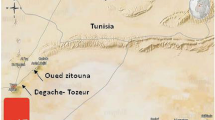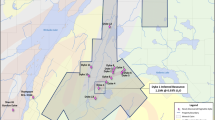Abstract
Efficient separation of trace muscovite from the surface/interface of quartz grains was accomplished during oxidizing calcination and catalytic pressure leaching of the hydrothermal quartz. Experimental results suggest that 98.97% or more of the muscovite was separated when quartz sand was calcined at 900 °C for 5 h and then leached by hydrochloric acid and ammonium chloride solutions as substitutes for leaching agents containing fluorides. The chemical processing techniques show high selectivity in purifying quartz sand by transforming mineral muscovite into active structures during oxidizing calcination, and then dissolving the active substances during catalytic pressure leaching.















Similar content being viewed by others
References
Scott HS (1957) The decrepitation method applied to minerals with fluid inclusions. Econ Geol 43:637–654. https://doi.org/10.2113/gsecongeo.43.8.637
Smith FG (1957) Decrepitation characteristics of igneous rocks. Can Mineral 6:78–86
Wang L, Li CX, Wang Y, Yin DQ (2011) China technologies present of high-purity quartz processing and the development propositions. J Mineral Petrol 31:110–114. https://doi.org/10.3969/j.issn.1001-6872.2011.04.017
Vatalis KI, Charalampides G, Platias S, Benetis NP (2014) Market developments and industrial innovative applications of high purity quartz refines ☆. Proc Econ Fin 14:624–633. https://doi.org/10.1016/S2212-5671(14)00751-5
Wang L, Dang CP, Li CX, Wang Y, Wei YY, Xia JZ, Pan JL (2014) Technology of high-purity quartz in China: status quo and prospect. Earth Sci Front 21:267–273. https://doi.org/10.13745/j.esf.2014.05.021
Santos MFM, Fujiwara E, Schenkel EA, Enzweiler J, Suzuki CK (2015) Processing of quartz lumps rejected by silicon industry to obtain a raw material for silica glass. Int J Miner Process 135:65–70. https://doi.org/10.1016/j.minpro.2015.02.002
Fraundorf GK, Shive L (1990) Transmission electron microscope study of quartz crucibles used in growth of Czochralski silicon. J Cryst Growth 102:157–166. https://doi.org/10.1016/0022-0248(90)90897-T
Minami T, Maeda S, Higasa M, Kashima K (2011) In-situ observation of bubble formation at silicon melt–silica glass interface. J Cryst Growth 318:196–199. https://doi.org/10.1016/j.jcrysgro.2010.10.075
Yamahara K, Huang X, Sakai S, Utsunomiya A, Tsurita Y, Hoshikawa K (2001) Surface of silica glass reacting with silicon melt: effect of raw materials for silica crucibles. Jpn J Appl Phys 40:1178–1182. https://doi.org/10.1143/JJAP.40.1178
Edvardmikhailovich B, Nick C, Igorantonovich K, Mamikonaramovich M, John S, Ivanmerabovich T (2008) Killing bacteria present on surfaces in films or in droplets using microwave UV lamps. World J Microbiol Biotechnol 24:761–769. https://doi.org/10.1007/s11274-007-9536-y
Macaluso AL, Mitchell DL, Sanders RW (2009) Direct effects of UV-B radiation on the freshwater heterotrophic nanoflagellate Paraphysomonas sp. Appl Environ Microbiol 75:4525–4530. https://doi.org/10.1128/AEM.02803-08
Dhamrin M, Saitoh T, Kamisako K, Yamada K, Araki N, Yamaga I, Sugimotoc H, Tajimac M (2009) Technology development of high-quality n-type multicrystalline silicon for next-generation ultra-thin crystalline silicon solar cells. Sol Energy Mater Sol Cells 93:1139–1142. https://doi.org/10.1016/j.solmat.2009.02.011
Kvande R, Arnberg L, Martin C (2009) Influence of crucible and coating quality on the properties of multicrystalline silicon for solar cells. J Cryst Growth 311:765–768. https://doi.org/10.1016/j.jcrysgro.2008.09.152
Griscom DL (2006) Self-trapped holes in pure-silica glass: a history of their discovery and characterization and an example of their critical significance to industry. J Non-Cryst Solids 352:2601–2617. https://doi.org/10.1016/j.jnoncrysol.2006.03.033
Schreiber A, Kühn B, Arnold E, Schilling FJ, Witzke HD (2005) Radiation resistance of quartz glass for VUV discharge lamps. J Phys D Appl Phys 38:3242–3250. https://doi.org/10.1088/0022-3727/38/17/S28
Kuzuu N, Horikoshi H, Nishimura T, Kokubo Y (2003) Effects of heat treatment on absorption bands in OH-free and OH-containing fused quartz. J Appl Phys 93:9062–9071. https://doi.org/10.1063/1.1572542
Nie YM, Lu XL, Niu FS (2013) Purification experiment research of quartz sand. Appl Mech Mater 389:346–348. https://doi.org/10.4028/www.scientific.net/AMM.389.346
Veglió F, Passariello B, Barbaro M, Plescia P, Marabini AM (1998) Drum leaching tests in iron removal from quartz using oxalic and sulphuric acids. Int J Miner Process 54:183–200. https://doi.org/10.1016/S0301-7516(98)00014-3
Wang L, Sun W, Hu YH, Xu LH (2014) Adsorption mechanism of mixed anionic/cationic collectors in muscovite–quartz flotation system. Miner Eng 64:44–50. https://doi.org/10.1016/j.mineng.2014.03.021
Li X, Li T, Gao J, Huang H, Li L, Li J (2016) A novel “green” solvent to deeply purify quartz sand with high yields: a case study. J Ind Eng Chem 35:383–387. https://doi.org/10.1016/j.jiec.2016.01.018
Sarit D, Oliver S, Halls MD, Sungho C, Chabal YJ, Feldman LC (2009) Chemical properties of oxidized silicon carbide surfaces upon etching in hydrofluoric acid. J Am Chem Soc 131:16808–16813. https://doi.org/10.1021/ja9053465
Larsen E, Kleiv RA (2016) Flotation of quartz from quartz-feldspar mixtures by the HF method. Miner Eng 98:49–51. https://doi.org/10.1016/j.mineng.2016.07.021
An J, Lee HA, Lee J, Yoon HO (2015) Fluorine distribution in soil in the vicinity of an accidental spillage of hydrofluoric acid in Korea. Chemosphere 119C:577–582. https://doi.org/10.1016/j.chemosphere.2014.07.043
Kline WE, Fogler HS (1981) Dissolution kinetics: the nature of the particle attack of layered silicates in HF. Chem Eng Sci 36:871–884. https://doi.org/10.1016/0009-2509(81)85041-5
Lin M, Pei ZY, Lei SM, Liu YY, Xia ZJ, Xie FX (2018) Trace muscovite dissolution separation from vein quartz by elevated temperature and pressure acid leaching using sulphuric acid and ammonia chloride solutions. Physicochem Probl Miner Process 54:448–458. https://doi.org/10.5277/ppmp1839
Lin M, Liu YY, Lei SM, Ye Z, Pei ZY, Li B (2018) High-efficiency extraction of Al from coal-series kaolinite and its kinetics by calcination and pressure acid leaching. Appl Clay Sci 161:215–224. https://doi.org/10.1016/j.clay.2018.04.031
Xiong K, Lei SM, Zhong LL, Pei ZY, Yang YY, Zang YY (2016) Thermodynamic mechanismand purification of hot press leaching with vein quartz. China Min Mag 25:129–132. https://doi.org/10.3969/j.issn.1004-4051.2016.02.025
Lin M, Lei SM, Pei ZY, Liu YY, Xia ZJ, Xie FX (2018) Application of hydrometallurgy techniques in quartz processing and purification: a review. Metall Res Technol 115:303. https://doi.org/10.1051/metal/2017105
Xue NN, Zhang YM, Liu T, Huang J, Zheng QS (2017) Effects of hydration and hardening of calcium sulfate on muscovite dissolution during pressure acid leaching of black shale. J Clean Prod 149:989–998. https://doi.org/10.1016/j.jclepro.2017.02.152
Lin M, Pei ZY, Lei SM (2017) Mineralogy and processing of hydrothermal vein quartz from Hengche, Hubei Province (China). Minerals 7:161. https://doi.org/10.3390/min7090161
Pei ZY, Lin M, Liu YY, Lei SM (2018) Dissolution behaviors of trace muscovite during pressure leaching of hydrothermal vein quartz using H2SO4 and NH4Cl as leaching agents. Minerals 8:282. https://doi.org/10.3390/min8020060
Lin M, Pei ZY, Li YB, Liu YY, Wei ZL, Lei SM (2018) Separation mechanism of lattice-bound trace elements from quartz by KCl-doping calcination and pressure leaching. Miner Eng 125:42–49. https://doi.org/10.1016/j.mineng.2018.05.029
Götze J, Plotze M, Graupner T, Hallbauer DK, Bray CJ (2004) Trace element incorporation into quartz: a combined study by ICP-MS, electron spin resonance, cathodoluminescence, capillary ion analysis, and gas chromatography 1. Geochim Cosmochim Acta 68:3741–3759. https://doi.org/10.1016/j.gca.2004.01.003
Ellison A, Cornejo IA (2010) Glass substrates for liquid crystal displays. Int J Appl Glas Sci 1:87–103. https://doi.org/10.1111/j.2041-1294.2010.00009.x
Gao X, Zhang Q, Yu J, Tang W, Li Y, Lu A (2018) Effect of replacement of Al2O3 by Y2O3 on the structure and properties of alkali-free boro-aluminosilicate glass. J Non-Cryst Solids 481:98–102. https://doi.org/10.1016/j.jnoncrysol.2017.10.032
Liu C, Lin J (2008) Influence of calcination temperature on dielectric constant and structure of the micro-crystalline muscovite. China Non-Met Min Ind Her 5:38–46. https://doi.org/10.3969/j.issn.1007-9386.2008.05.012
Bogatko S, Moens J, Geerlings P (2010) Cooperativity in Al3+ hydrolysis reactions from density functional theory calculations. J Phys Chem A 114:7791–7799. https://doi.org/10.1021/jp102787e
Hou XX, Dong SN, Zhang J, Shu-Ping BI (2016) DFT study of the static structural and ~(27)Al−/~(17)O−/~1H-NMR characteristics for the third hydration shell of Al~(3+)(aq) complexes. J Anal Sci 32:149–155. https://doi.org/10.13526/j.issn.1006-6144.2016.02.001
Lee KY, Yoon YY, Jeong SB, Chae YB, Ko KS (2009) Acid leaching purification and neutron activation analysis of high purity silicas. J Radioanal Nucl Chem 282:629–633. https://doi.org/10.1007/s10967-009-0318-x
Lin M, Pei ZY, Liu YY, Xia ZJ, Xiong K, Lei SM, Wang EW (2017) High-efficiency trace Na extraction from crystal quartz ore used for fused silica — a pretreatment technology. Int J Miner Metall Mater 24:1075–1086. https://doi.org/10.1007/s12613-017-1498-y
Acknowledgements
Financial support for the project was provided by the National Natural Science Foundation of China (51604205, 51774223).
Author information
Authors and Affiliations
Corresponding authors
Ethics declarations
Conflict of Interest
The authors declare no conflict of interest.
Rights and permissions
About this article
Cite this article
Pei, Z., Lin, M., Meng, Y. et al. Efficient Separation of Trace Muscovite within the Surface/Interface of Quartz Grains from a Hydrothermal Deposit by Oxidizing Calcination and Catalytic Pressure Leaching. Mining, Metallurgy & Exploration 36, 313–325 (2019). https://doi.org/10.1007/s42461-018-0033-7
Received:
Accepted:
Published:
Issue Date:
DOI: https://doi.org/10.1007/s42461-018-0033-7




